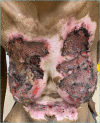Galactorrhoea and Hyperprolactinaemia in a Non-Pregnant Female with Burns
- PMID: 33376475
- PMCID: PMC7745297
Galactorrhoea and Hyperprolactinaemia in a Non-Pregnant Female with Burns
Abstract
Galactorrhoea is the presence of breast milk secretion in non-pregnant or non-breastfeeding females. In females with galactorrhoea and amenorrhoea, hyperprolactinaemia is the most likely cause. Chest wall pathology is a known cause of hyperprolactinaemia, however there are few documented reports on galactorrhoea following burn injury to the chest wall. We report a case of an adult female patient who sustained hot water burns to her torso. Following the second skin graft failure, galactorrhoea was noted and investigated. Hyperprolactinaemia was found with normal renal and thyroid function. There were no abnormalities detected on the hormones in the hypothalamic pituitary axis and MRI. Hyperprolactinaemia was attributed to chest wall injuries causing pathological stimulation of the neural suckling reflex. The patient was treated with dopamine agonists for one month and the galactorrhoea disappeared. Treatment was discontinued on discharge and the prolactin levels remained normal upon follow-up visit to the clinic.
Keywords: chest burns; galactorrhoea; hyperprolactinaemia; prolactin.
Copyright © 2020 International Federation of Clinical Chemistry and Laboratory Medicine (IFCC). All rights reserved.
Conflict of interest statement
The authors declare that they have no competing interests.
Figures
Similar articles
-
Galactorrhoea, amenorrhoea and hyperprolactinaemia after an operation on the breast: A case report.S Afr Med J. 1980 Jan 19;57(3):95-6. S Afr Med J. 1980. PMID: 7190737
-
Juvenile granulosa cell tumour of the ovary presenting with hyperprolactinaemic amenorrhoea and galactorrhoea.Endocrinol Diabetes Metab Case Rep. 2016;2016:160006. doi: 10.1530/EDM-16-0006. Epub 2016 Feb 23. Endocrinol Diabetes Metab Case Rep. 2016. PMID: 27047664 Free PMC article.
-
Galactorrhoea following surgical procedures to the chest wall: the role of prolactin.Postgrad Med J. 1980 Jan;56(651):23-5. doi: 10.1136/pgmj.56.651.23. Postgrad Med J. 1980. PMID: 7189882 Free PMC article.
-
Current treatment issues in female hyperprolactinaemia.Eur J Obstet Gynecol Reprod Biol. 2006 Apr 1;125(2):152-64. doi: 10.1016/j.ejogrb.2005.10.005. Epub 2005 Nov 9. Eur J Obstet Gynecol Reprod Biol. 2006. PMID: 16288952 Review.
-
Antipsychotic-induced hyperprolactinaemia: mechanisms, clinical features and management.Drugs. 2004;64(20):2291-314. doi: 10.2165/00003495-200464200-00003. Drugs. 2004. PMID: 15456328 Review.
Cited by
-
The curious case of milk collection under skin graft over the breast: Lessons learned!J Postgrad Med. 2024 Jan-Mar;70(1):53-55. doi: 10.4103/jpgm.jpgm_969_22. J Postgrad Med. 2024. PMID: 38197335 Free PMC article.
References
-
- Leung AKC, Pacaud D. Diagnosis and management of galactorrhea. Am Fam Physician. 2004;70(3):543-550. - PubMed
-
- Bernard V, Young J, Chanson P, Binart N. New insights in prolactin: pathological implications. Nat Rev Endocrinol. 2015; 11:265–275. - PubMed
-
- Kavanagh L, McKenna TJ, Fahie-Wilson MN, Gibney J, Smith TP. Specificity and Clinical Utility of Methods for the Detection of Macroprolactin. Clin Chem. 2006;52(7): 1366–1372. - PubMed
-
- Melmed S, Casanueva FF, Hoffman AR, Kleinberg DL, Montori VM, Schlechte JA, et al. Diagnosis and Treatment of Hyperprolactinemia: An Endocrine Society Clinical Practice Guideline. J Clin Endocrinol Metab. 2011;96(2): 273–288. - PubMed
Publication types
LinkOut - more resources
Full Text Sources


